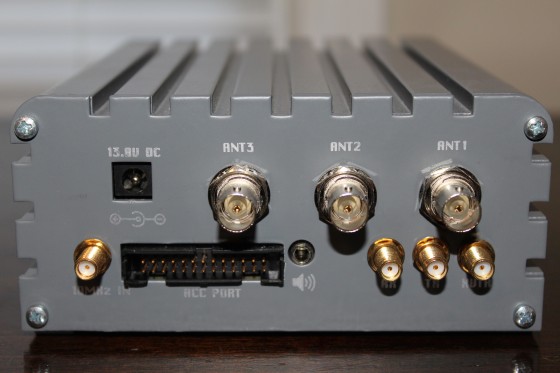Headphone Jack – This is a 3.5mm stereo jack for either stereo headphones or can be used to connect stereo powered speakers. Using stereo headphones or stereo speakers have the advantage of letting you monitor the Anan 10E’s two independent receivers simultaneously. It will also allow you to use PoweSDR’s binaural feature which can improve the copy of certain signals by bringing them more forward in the audio,
Key– For connecting a CW key.
Lan Jack -This allows you to connect the Anan 10E directly to your computers Ethernet jack, which is the simplest way of connecting the Anan 10E to your computer. You can also connect the Anan 10E to your internet router if you wish which has the advantage of allowing all the computers on your network be able to access the Anan 10E. You also can connect the Anan 10E to a wireless bridge or router. This will give you the ability to access the Anan 10E remotely from wireless laptops or tablets. In testing the Anan 10E with wireless connections worked reasonably well as long as a wireless N router was used. However depending on the distance and such, the sample rate may have to be decreased to 192kHz or lower. If you have a newer wireless AC router with wireless AC adapters connected to your computer, wireless access to the Anan 10E at 384kHz will work very well. By plugging the Anan 10E into a wireless AC bridge, you could locate the Anan 10E well away from your shacks computer systems if the computers happen to be big RF generators.
Power Switch – Push Button power switch.
Rear Panel Connections

13.8V DC – Power supply connection
Ant Jacks – The Anan 10E provides you with 3 antenna jacks. You can use these SMA jacks to connect 3 independent antennas. For example you could connect a beam, dipole, and a vertical antenna to the jacks. PowerSDR can then be configured to automatically switch to one of these antennas depending on the band you have selected for receive or transmit. There are also facilities in PowerSDR that can provide even more sophisticated use of these antenna ports for applications such as attaching power amps or transverters.
External 10mHz Reference Jack – This allows you to connect an external reference signal generator to keep the selected frequency extremely accurate and stable. You may find this useful for some very high frequency applications where extreme frequency stability may be necessary.
ACC Port – This is a DB25 connector that can be used for advanced interfacing to external devices.
Mono Speaker Jack – The speaker jack is a mono 3.5mm jack that will allow you to plug in a standard non-powered mono speaker. The Anan 10E has a built in 1W amplifier that will drive an external speaker. Testing with several types of speakers showed that the internal amp provided plenty of output with a very decent sound quality.
RX SMA Connector*
TX SMA Connector *
Transverter Jack- Usually not enabled.
* The RX SMA and TX SMA are typically used for advanced interfacing purposes such as using Pure Signal with external amplifiers.
The Software

The main software application for the Anan 10E is PowerSDR_mRX which is a version of PowerSDR that has been modified to work with the OpenHPSDR standard and heavily supports the Apache Labs series of SDR radios. PowerSDR_mRX will run under Windows. PowerSDR is probably the most feature rich SDR software program available and interfaces well with numerous 3rd party programs. The PowerSDR_mRX version pretty much ready to go out of the box to support the numerous features and settings of the Anan 10E. Not to mention, if you want to transmit using the Anan 10E, you will definitely want to use PowerSDR_mRX since it supports Anan 10E antenna switching, Pure Signal, the Anan 10E’s dual receivers and much more. The thing main advantage of PowerSDR_mRX is that you can tweak the Anan 10E’s numerous settings for your purposes. The bad, thing is you can mess things up if you aren’t careful. Thankfully most of the setting panels of PowerSDR_mRX have a reset button. You can also save your configurations in PowerSDR_mRX so the settings can be restored if needed.
Another neat piece of software for the Anan series of cuSDR for Windows. The cuSDR software is still pretty much a beta release and does not support transmit yet. cuSDR supports the Anans 10E’s realtime spectrum display from 0-55mHz. Needless to say this a pretty cool feature when viewed action. You can click on the full range display and have the Anan 10E pretty close the frequency of interest. The signal tuning can then be more refined in cuSDR’s main spectrum window. cuSDR also supports the second full range receiver as well, to allow you simultaneously monitor two separate bands independently. For you Shortwave Listeners out there, cuSDR may be your go to program for casual monitoring with Anan 10E since cuSDR has great audio quality.
Current versions of PowerSDR_mRX and cuSDR can be downloaded from the OpenHpsdr web site.
Mac users have the option of using a native OSX program called Heterodyne. However, this program is very basic. To get the full use of the Anan 10E, you will be better off using Windows under bootcamp or Parallels with a Windows virtual machine. PowerSDR will work quite well with a Windows virtual machine if you dedicate most of the Mac resources to the virtual machine. How well Parallels will actually works in this scenario will also be dependent on the processing power of your Mac. Testing was performed on a quad core i5 iMac which performed quite well. However, you are always going to get the best performance with Windows running under Bootcamp.

Reduction of ADC # of bits by 2 reduces dynamic range by 1S unit ( -6dB)!
I wonder how one copes with this with respect to settings of gain distribution according to K3NA excellent recommendations ( google)!
Pierre,
F3WT
The 14-bit LTC2208 has a noise floor of -77.1 dBFS versus -78 for the 16-bit part. The SFDER is 98 dB versus 100 dB. I think the difference in *effective* number of bits is less than 1. The Perseus uses the 14-bit part and its performance is extremely close to that of designs using the 16-bit part.
Now, has anyone actually *measured* the performance difference in receive between the ANAN-10 and the ANAN-10E? Apart from advertising claims and some hand waving, I have seen no actual measured data published.
Thanks!
73,
Lyle KK7P
the calculation is not correct: 2 bits less cause a nominal degration of DR of 2 x 6.02dB = 12.04 dB! But we have to consider the ENOB ( effective number of bits)defined for each ADC and there difference is not so significant. We measured approx. 4 dB reduction
I have both the 10E and the 100D. Since I am a low band operator (160m primarily) the 100D is AWESOME!. With narrow filters and the NB2 noise reduction I can even use my transmit antenna and copy very weak signals. I have used both the 10E and 100D on an A/B comparison and the difference is barely noticeable. There is a new model about to be released and if the software can keep up with the new hardware the Flex users will soon be Apache Labs followers.